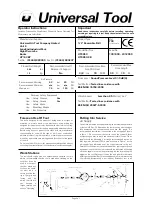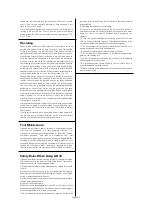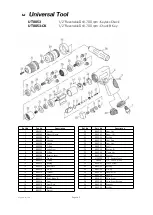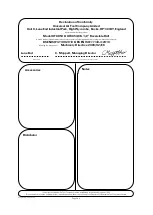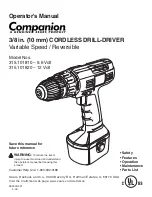
Operating
Select suitable drill bit, insert the shank into the drill chuck as far as
possible and tighten chuck by hand (keyless) or with key supplied
(chuck & key) making sure that the shank of the device is securely
clamped centrally between the three chuck jaws. Remove chuck key.
When drilling holes of all sizes it is advised to use a pointed punch to
mark the centre at which the hole is to be drilled as this will provide
a starting point for the drill tip. This procedure will prevent the drill bit
from skidding, ensure that the hole is drilled where intended and help
to prevent drill breakage when using small drills. When drilling,
particularly with small diameter drills, always try to ensure that load
applied to the drill is such that the drill bit is always at right angles to
the hole being drilled. Do not force the drill but allow it to cut.
When drilling always adopt a firm posture to be able to counteract
any sudden movement of the drill due to torque reaction. Such torque
reaction can occur when the drill stalls due to a too heavy load being
applied or the material being too hard or tough. The torque reaction
can occur when the drill breaks through the material being drilled,
particularly on sheet metal. Always use eye protection and hand
protection is advised, particularly when drilling holes in metals where
the material being removed from the hole is in the form of long sharp
strips. If present, do not tie the drill chuck key to the drill as the
attaching device i.e. string or chain could become entangled with the
rotating chuck and bit etc.
If using an abrasive device, drilling stone or performing any operation
where dust is created, it is recommended to use a breathing mask.
Always ensure that the material to be drilled is firmly fixed to prevent
its movement.
It is also recommended that when drilling holes of large diameter to
first pre drill a hole of smaller diameter as this will reduce effort
required to drill the hole and minimise torque reaction.
supply and run tool slowly for a few seconds to allow air to circulate
the oil. If tool is used frequently lubricate on daily basis and if tool
starts to slow or lose power.
It is recommended that the air pressure at the tool whilst the tool is
running is 90 p.s.i./6.3 bar. The tool can run at lower and higher
pressures with the maximum permitted working air pressure of 100
p.s.i./7.0 bar.
Page No 2
Tool Maintenance
It shall be the tool owner’s and/or employer’s responsibility to assure
that tools are maintained in a safe operating condition. Tool
maintenance and repair shall be performed by authorised, trained,
competent personnel. Tools shall be disconnected from their
compressed air supply before repairs are attempted. Repairs shall be
consistent with the manufacturer’s recommended procedures. Tool,
hoses and fittings shall be replaced if unsuitable for safe operation. It
shall be the tool owner’s and/or employer’s responsibility to keep
required rating markings and warnings on the tool in legible condition.
pressures as this will allow the drill to stall more easily and develop
torque reaction.
8) Use safety equipment as recommended.
9) The tool is not electrically insulated. Do not use where there is a
possibility of coming into contact with live electricity, gas pipes, water
pipes, etc. Check the area of operation before performing the
operation.
10) Take care against entanglement of moving parts of the tool with
clothing, ties, hair, cleaning rags, etc. This will cause the body to be
moved towards the work process and can be very dangerous.
11) Do not attempt to hold or guide the drill chuck when the tool is
running. Keep hands clear of the drilling process.
12) Use only compressed air at recommended conditions.
13) Do not attempt to fit attachments, i.e. for sawing, hedge cutting,
grinding, chain sawing, etc.
14) If the tool appears to malfunction remove from use immediately
and arrange for service and repair.
15) If an additional side handle is fitted to the tool ensure that it is
correctly positioned and fixed securely.
16) If the drill is used with a balancer or other suspension device ensure
that it is fixed securely.
Safety Rules When Using A Drill
1) Read all the instructions before using this tool. All operators must be
fully trained in its use and aware of these safety rules. All service and
repair must be carried out by trained personnel.
2) Always select a suitable cutting, abrasive device suitable for use with
this drill.
3) Always shut off the air supply to the drill and depress the trigger to
exhaust air from the feed hose before fitting, adjusting or removing the
cutting or abrasive device or drill chuck.
4) Always adopt a firm footing and/or position and be aware of torque
reaction developed by the drill.
5) Use only correct spare parts.
6) Check hose and fittings regularly for wear. Do not carry the tool by its
hose and ensure that the hand is remote from the on/off valve (trigger)
when carrying the tool with air supply connected.
7) Do not exceed maximum recommended air pressure. Avoid low air

